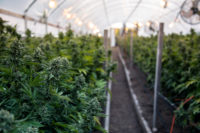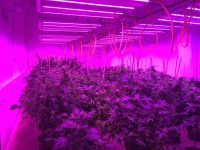Many people associate cannabis with eco-friendly, counter-cultural movements, but we know the environmental impacts of the cannabis industry are significant. Given the climate crisis, cannabis production companies have a responsibility to ensure future demands of the industry are met in an environmentally sustainable way. We also know that as the world is seeing the impacts of climate change, consumers are changing their spending habits 1. As a result, companies also have the financial incentive to seriously consider implementing more environmental policies, to align their interests with the interests of consumers. Unfortunately, restrictions on cannabis research and the legal industry create barriers to implementing many environmentally friendly alternatives in production. However, this does not give us an excuse to do nothing while we wait – there are many steps that can be taken while we work to overcome these barriers. Our team at Delic Labs aims to help companies ensure the environmental and economic sustainability of the cannabis industry. So, we did some research and developed the Cannabis Better Future (CBF) concept, a guide that considers the impacts of cannabis cultivation and processing on the environment. The pillars of CBF are:
- Use of renewable/recyclable materials in production
The packaging used for legal cannabis products is infamously excessive. A standard 3.5-grams of dried cannabis is estimated to come packaged in more than 70 grams of plastic. This seemingly redundant packaging is done to meet regulations surrounding cannabis packaging that often require single-use plastic with labels and warnings at specific sizes 2. Despite this, there is work being done to get biodegradable packaging approved in the industry.
More companies, such as Knot Plastic, are using plant-based materials to provide medical-grade biodegradable alternatives to single-use plastic 3. As members of the industry, we should support these companies and call for regulations to approve biodegradable packaging. As for immediate actions that can be taken, we can turn to companies that reduce the amount of plastic from the industry that ends up in landfills. The Tweed x TerraCycle Cannabis Packaging Recycling Program accepts all cannabis containers from licensed producers in Canada – free of charge – and melts down the plastic to create new products 4. This includes tins, plastic bags, tubes and bottles with child-proof caps. The program has saved more than 165,000 containers from ending up in landfills.
- Upcycle biomass waste
It is estimated that for every pound of cannabis harvested, up to 4.5 pounds of plant waste is generated 5. Cannabis biomass waste can be discarded in four different ways: via landfill, composting, in-vessel digestion or incineration 6. Cannabis bio-waste usually ends up in landfills because this is the cheapest method. However, landfill disposal represents a missed opportunity for companies to use biomass waste for economic and environmentally-friendly uses.

To reduce landfill waste, some companies are looking at sustainable bio-circular solutions, where cannabis biomass is converted into something of industrial use such as compost, bio-plastics and paper packaging for cannabis products 7. The easiest way to reuse cannabis biomass with current regulations in place is to upcycle it to produce compost and greywater that can be used for industrial cultivation 8. Currently, bleach is commonly used to remove THC from biomass, making it unfit to be used for these purposes 6. However, Micron Waste Technologies Inc. have shown enzymatic denaturation can be adopted on the industrial scale to remove THC from the biomass, resulting in reusable water and compostable matter 8. Turning to this alternative method would also reduce the amount of required fertilizer and replace bleach with a more environmentally-friendly solution.
- Recycle production side streams
Terpenes are the compounds in cannabis that give it distinctive aromas and flavors sought after by consumers.During the cannabis drying stage, over 30% of terpenes can be lost along with the water phase from the product 9. This terpene-containing water phase gets trapped in drying rooms and decarboxylation ovens and is usually thrown out. To reintroduce the terpenes in their products, companies usually purchase them 10.However, they instead could be recapturing terpenes that are otherwise going to waste, and re-introducing them into their products. Recapturing terpenes would not only reduce the production and shipment energy that goes along with purchased terpenes, but also the costs of buying them.
There are many other wasted by-products that can be recycled. Ethanol that has been used as extraction solvent can be reused as cleaning solvent, reducing the need to purchase ethanol separately for cleaning purposes. Further, the condensation caught in HVACs can be recycled to water plants.
- Optimize production energy efficiency

A study by Summers et al. 11 found that from producing one kilogram of dried cannabis flower, the emitted greenhouse gasses emissions range from 2,283 to 5,184 kg of CO2. Electricity used for indoor cultivation is the major culprit in producing these emissions. In fact, over $6 billion is spent annually to power industrial cannabis growth facilities in the U.S. alone12. Growing outdoors is significantly more energy efficient; however, non-auto flowering, high-THC cannabis plants depend on the specific timing of daylight (and darkness) to grow properly 13. Optimal conditions for these plants are not always achievable in outdoor setting. Meanwhile, auto-flowering plants that are hearty outdoors are generally lower in THC content 14. Promoting research into generating more stabilized cannabis cultivars may help outdoor growing be a more feasible solution. Given the recent work being done with genetically modified and transgenic plants, upregulating THC production in cannabis and increasing the heartiness in different climates is well within the realm of possibility 15–17.
In the meantime, cultivation facilities can do their part to maintain a controlled growth environment with reduced energy waste. Companies that are still using high-intensity sodium lights should consider switching to high-efficiency LED bulbs 12. These are a good alternative option as they produce less heat, and as a result, require less mechanical cooling. It has been shown that many plants, including cannabis, might even do better under blue-red LED lights 18,19. Growth under these conditions correlated with an increase in THC and CBD levels, and overall larger plants 18. In addition to low energy consumption, LED lamps have flexible mobility and a tunable spectrum range. This makes it possible to mediate the spectrum specifically for cannabis crops by controlling each spectral range and manipulating spectral quality and light intensity precisely. Finally, lights can also be brought closer to plants, to further reduce the amount of mechanical cooling needed.
- Utilize high-precision processes
Reducing energy use while maintaining production rates can only be done if the process is optimized. Our own research improves process optimization in the cannabis industry. A key component of industrial optimization is reducing wasted time on various machines. For cannabis producers, this machine “junk time” can accumulate when the instrumentation is not progressing the reaction.
Reducing energy use in this case means ensuring machines are not in operation if they are not progressing the reaction. For example, many companies spend approximately two hours on the decarboxylation step because decarboxylation is always complete after two hours 20; however, decarboxylations are often complete in as little as thirty minutes 21. Companies can save energy by installing a monitor on decarboxylation systems to stop reactions once they are complete.
Reducing the environmental impacts of the cannabis industry is crucial to combat the developing climate crisis. While lifting restrictions on cannabis research and mitigating stigmas surrounding the legal industry will be what ultimately paves the way for meaningful changes toward a sustainable industry, cannabis companies cannot wait for regulatory changes to occur before considering eco-friendly practices. As outlined by CBF, there are existing actions which all companies can take to reduce their carbon footprint immediately. Delic Labs, and many other companies we have noted, aim to support companies in making these decisions for a better future for cannabis.
References:
- Statista Research Department. Share of consumers worldwide who have changed the products and services they use due to concern about climate change in 2019. https://www.statista.com/statistics/1106653/change-made-consumer-bevaviour-concern-climate-change-worldwide/ (2021).
- Akeileh, O., Moyer, E., Sim, P. & Vissandjee Amarsy, L. Chronic Waste: Strategies to Reduce Waste and Encourage Environmentally-Friendly Packaging in Canada’s Legal Cannabis. https://www.mcgill.ca/maxbellschool/files/maxbellschool/policy_lab_2020_-_strategies_to_reduce_waste_and_encourage_environmentally-friendly_packaging_in_canadas_legal_cannabis_industry.pdf (2020).
- Bauder, P. Ry Russell of Knot Plastic️: 5 Things We Must Do to Inspire the Next Generation about Sustainability and the Environment. (2020).
- Waste360 Staff. Tweed, TerraCycle Take Cannabis Packaging Recycling Across Canada. (2019).
- Peterson, E. Industry Report: The State of Hemp and Cannabis Waste. CompanyWeek (2019).
- Commendatore, C. The Complicated World of Cannabis Waste Generation (Part One). Waste 360 (2019).
- Drotleff, L. Cannabis-based packaging and paper could reduce waste, promote sustainability. MJBiz Daily(2020).
- Waste 360 staff. Micron Secures U.S. Design Patent for Waste Treatment Tech. Waste 360 (2019).
- Challa, S. R. DRYING KINETICS AND THE EFFECTS OF DRYING METHODS ON QUALITY (CBD, TERPENES AND COLOR) OF HEMP (Cannabis sativa L.) BUDS. (2020).
- Erickson, B. Cannabis industry gets crafty with terpenes. chemical and engineering news (2019).
- Summers, H. M., Sproul, E. & Quinn, J. C. The greenhouse gas emissions of indoor cannabis production in the United States. Nature Sustainability 4, (2021).
- Reott, J. How Does Legalized Cannabis Affect Energy Use? Alliance to Save Energy (2020).
- When To Plant Cannabis Outside: A State By State Guide. aPotforPot.comhttps://apotforpot.com/blogs/apotforpot/when-to-plant-cannabis-outside-a-state-by-state-guide/ (2020).
- 15 Pros And Cons of Autoflowering Cannabis. aPotforPot.com https://apotforpot.com/blogs/apotforpot/15-pros-and-cons-of-autoflowering-seeds/ (2019).
- Ye, X. et al. Engineering the Provitamin A (β-Carotene) Biosynthetic Pathway into (Carotenoid-Free) Rice Endosperm. Science 287, 303–305 (2000).
- Giddings, G., Allison, G., Brooks, D. & Carter, A. Transgenic plants as factories for biopharmaceuticals. Nature Biotechnology 18, 1151–1155 (2000).
- Hu, H. & Xiong, L. Genetic Engineering and Breeding of Drought-Resistant Crops. Annual Review of Plant Biology 65, 715–741 (2014).
- Wei, X. et al. Wavelengths of LED light affect the growth and cannabidiol content in Cannabis sativa L. Industrial Crops and Products 165, (2021).
- Sabzalian, M. R. et al. High performance of vegetables, flowers, and medicinal plants in a red-blue LED incubator for indoor plant production. Agronomy for Sustainable Development 34, (2014).
- LunaTechnologies. Decarboxylation: What Is It and Why Is It Important? LunaTechnologies.
- Shah, S. et al. Fast, Easy, and Reliable Monitoring of THCA and CBDA Decarboxylation in Cannabis Flower and Oil Samples Using Infrared Spectroscopy. (2021).
The post At Delic Labs, We Have a Dream: A Cannabis Better Future appeared first on Cannabis Industry Journal.

